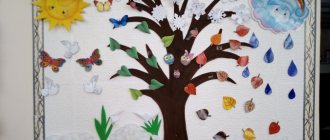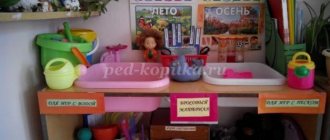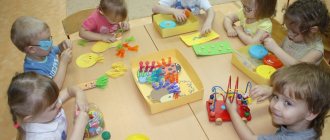PROJECT “Game educational space in preschool educational institutions”
Secondly, this is the play activity of children according to their interests, desires and choice of space, which will ensure the development of motor, mental and speech skills in preschoolers, develop the child’s creative abilities, since it will take place according to the child’s own “scenario”. During the game, the child realizes his cognitive, aesthetic and moral needs, and creates his own educational route.
This is a position to improve the quality of the educational process by creating a play space taking into account educational objectives, giving the child the opportunity to choose the type of activity, games, toys and a creative adult partner. Carrying out educational activities in forms specific to preschool children, in the form of games. The child does not need to hear the information, but to live it, i.e. play something in a role-playing game, a theatrical game, where the child figuratively participates and transforms into someone. The child needs to solve some problems assigned to him in a didactic, educational game, in a game with rules.
Novelty of the project
- this is the construction of a new pedagogical form of the educational process, variable developmental education, focused on the possibility of children’s free choice of games, materials, types of activities, participants in joint activities and communication, both with children of different ages and with adults, as well as freedom in expressing their feelings and thoughts. This is the determination of the components and principles of designing a gaming educational space, pedagogical support for an individual educational trajectory, and ensuring the personal and social success of each child.
Components of the gaming educational space of MDOBU “Medvedev kindergarten No. 4 “Romashka”
— Development of space and environment.
The design of models of educational spaces within an institution is focused on the principles of preserving the life and health of the child and the active position of the child. The content richness, transformability, and dynamism of the educational environment will be adapted to meet the needs and interests of the child himself, when he gets the opportunity to constantly feel like a full owner of toys, move freely around the kindergarten, and enjoy the life of the children and adults around him. The environment will provide playful, educational, research and creative activity, experimentation with materials; motor activity, including the development of gross and fine motor skills, participation in outdoor games and competitions; emotional well-being of children in interaction with the subject-spatial environment; opportunity for children to express themselves. This is a play space in which the child will master the objective world and the world of relationships between people through games and multidirectional activities.
“Model of a gaming educational environment in the middle group” (methodological development)
Natalya Zinovieva
“Model of a gaming educational environment in the middle group” (methodological development)
Introduction
1. Main part
1.1. Theoretical rationale for choosing a topic
1.2 Practical part. Model of a gaming educational environment in
middle group
2. Conclusion
3. Application
4. References
Introduction
One of the most important factors in the development of a child’s personality is the environment in which he lives, plays, studies and relaxes. Children's activity cannot be complete on a purely verbal level, outside the objective environment, otherwise the child will lose the desire to learn new things, apathy and aggression will appear. The same sensations arise in parents when the object environment is dull, gray and unattractive. The surrounding space, which meets the requirements of the current immediate and long-term creative development of each child, and contributes to the timely identification and development of his abilities, will help to avoid the manifestation of such negative feelings.
Observations show that modern preschoolers do not know how to organize their activities and fill them with meaning. The majority do not have a developed imagination, they are creatively lacking initiative, and do not know how to think independently. Over the past five or six years, certain changes have occurred in children's games. The most obvious: kindergarten students began to play less, especially in role-playing games (both in quantity and duration). The main reason, according to adults, is lack of time.
Preschool age is the optimal period for personality formation. Therefore, the direction of a child’s activity and development depends on how the subject-spatial organization of their life is structured. Everything that surrounds a child shapes his psyche and is the source of his knowledge and social experience.
The purpose of this work is to develop a model of a gaming educational environment in the middle group of a preschool institution.
Objectives: to study new approaches in organizing a subject-development environment that ensures the full development of preschool children; organize a developmental environment that promotes the full development of children, taking into account their needs and interests; create conditions for providing different types of activities for preschool children (play, motor, intellectual, independent, creative, artistic, theatrical); to promote cooperation between children and adults to create a comfortable subject-development environment in preschool educational institutions.
Methods and sequence of innovations planned during the project:
1. Conduct an assessment and analysis of the subject-development environment of the preschool educational institutions, identifying the most problematic areas.
2. Study the interests, inclinations, preferences, characteristics of children in the group.
3. Make a list of necessary materials and equipment based on the principle of necessity and material capabilities.
4. Consider the sequence of making changes to the subject-spatial environment during the year, taking into account the educational program, the positive dynamics of children’s development, and the acquisition of new funds.
Planned results of the project:
-implementation of an innovative model of a modern subject-development environment,
-improving the gaming environment in group rooms by creating development centers in them,
-increasing the psychological and pedagogical competence of the teacher in the formation and use of a gaming educational environment; -transforming the group space in accordance with age characteristics and the requirements of the Federal State Educational Standard for Educational Education and with the introduction of new approaches to organizing the group environment;
1.Main part
The scientific and psychological foundations of the development of education and the foundations of organizing a developmental and play environment as an integral part of such education in relation to the preschool level are outlined in the works of outstanding domestic scientists of the twentieth century - L. S. Vygotsky, S. L. Rubinstein, A. N. Leontyev , A. V. Zaporozhets, D. B. Elkonina. Their followers L.A. Venger, F.A. Sokhin, N.N. Poddyakov, O.M. Dyachenko, G.G. Kravtsov worked and are working in this direction.
1.1Theoretical foundations of the project
The concept of an object-based play environment is considered in pedagogy as a narrower characteristic of the environment, as a factor that stimulates, guides, and develops the child’s activity. It influences the development of personality in a broad sense and the formation of narrower qualities, such as independence, activity, and observation.
To accomplish these tasks, the RPPS must be: content-rich; transformable; multifunctional; accessible ; safe.
The subject-spatial development environment is organized taking into account the requirements of the Federal State Educational Standard, where all five educational areas are clearly visible:
social and communicative development; cognitive development; speech development; artistic and aesthetic development; physical development.
When modeling a subject-spatial development environment, the following principles are taken into account:
1. The principle of distance, position during interaction;
2. The principle of activity, independence, creativity;
3. The principle of stability and dynamism;
4. The principle of integration and flexible zoning;
5. The principle of emotionality of the environment, individual comfort and emotional well-being of each child and adult;
6. The principle of combining conventional and extraordinary elements in the aesthetic organization of the environment;
7. The principle of openness - closedness;
8. The principle of taking into account gender and age differences in children.
For children of middle preschool age, it is necessary to take into account their need to play with peers and their ability to be alone. By the age of four, role-playing becomes the main activity for most children. The content of the game becomes more complex, many toys become unnecessary, as the imagination turns on and objects become substitutes, this allows them to be fully used in play activities. When organizing a subject environment in a group room for children of the middle group, you need to remember that the fifth year of life is a period of intensive growth and development of the child’s body. It is important to establish a reasonable motor mode, create conditions for organizing a variety of outdoor games and game tasks. The organization of life and upbringing of children in the fifth year of life is aimed at further developing the ability to understand the people around them, show a friendly attitude towards them, and strive for communication and interaction. The organization of the developmental environment in the middle group should be structured in such a way as to make it possible to most effectively develop the individuality of each child, taking into account his inclinations, interests, and level of activity.
1.2 Practical part
. Model of a gaming educational environment in the middle group.
Taking into account the above, I propose the following model of a gaming educational environment in the middle group, which includes the following centers
Group space
(constructive)"
"Corner of information and educational technologies"
"Center for Creative Activity"
"Music Corner"
The filling of the corners is presented in Appendix No. 1
General recommendations for building a developmental environment in a modern pre-school educational institution.
I believe that the presented model can be improved by including a group of interactive equipment in the educational space. For example, an interactive table, an interactive whiteboard, a set of gaming tablets or an interactive sandbox would greatly expand the possibilities for children to be involved in various activities.
2. Conclusion
The gaming educational environment plays a big role in the development of cognitive activity and education of preschool children. The equipment of the educational process of a preschool institution is formed in direct dependence on the content of education, age, experience and level of development of children and their activities. When solving problems of education and development of preschool children, the teacher must rely on the interrelation of these concepts: education, development, subject-development environment. If the objective-spatial environment in which the child operates is informative, variable, multifunctional, and corresponds to the level of mental development of the child, then harmonious, comprehensive development and upbringing of preschool children will be observed.
The developing subject-spatial environment in the group serves the development of children's activities, primarily play. After all, during the game a powerful cognitive motive is born, which is the basis of educational activity. Through a developing subject-spatial environment, we form cognitive activity in children.
The organization of the developmental environment in a preschool educational institution, taking into account the Federal State Educational Standard, is structured in such a way as to make it possible to most effectively develop the individuality of each child, taking into account his inclinations, interests, level of activity, and is the main means of shaping the child’s personality and the source of his knowledge, social experience and cognitive activity.
The model of the gaming educational environment of the group was created taking into account the above principles. It should be noted that such a construction of the environment gives children a sense of psychological security, helps the development of personality, cognitive activity, abilities, and mastery of different methods of activity.
The proposed gaming educational environment ensures the safety of their lives, promotes health and strengthens the body of each of them, and also stimulates children to develop cognitive, artistic and aesthetic abilities.
An optimally rich multifunctional environment has been created in the group room, providing the opportunity to organize various types of games with children, as well as to simulate the play environment in accordance with the game situation. The subject-game environment in the middle group was organized in such a way that each child had the opportunity to do what he loved, which allowed children to unite in subgroups based on common interests. When organizing the object-based play environment, the children’s interest in problems that go beyond their personal experience was taken into account. For many role-playing games, equipment and toys were introduced to expand children's personal experience. The subject-game environment was organized so that children could participate in the whole variety of games: role-playing games, construction-constructive games, director's games, theater games, folk games, round dances, etc. The created game environment, in my opinion, aroused cognitive activity, independence, responsibility and initiative.
The advantage of the created environment is that it is possible to involve all children in active independent activities. Each child chooses an activity of interest in any center, which is ensured by the variety of subject content, accessibility and ease of placement of materials. It was noted that pupils have less conflict with each other: they rarely quarrel over games, play space or materials, because they are passionate about interesting activities. The positive emotional mood of children indicates their cheerfulness, openness, and desire to attend kindergarten.
More opportunities are provided for independent activity, solitude, physical activity and
3. Applications.
Appendix No. 1 Filling corners
Direction of educational field
"Social-communicative"
Group space
The playing material is placed in boxes with pictures indicating that they contain doll dishes. In the center there is a shelf with thematic dolls (cook, stewardess, doctor, builder, decorated. Next to each doll there is a flag with a picture of this doll and poems about this profession. Also on the shelf there is a model of a doll's room - You. Along the edge of the shelf there is an openwork curtain in combination with a tablecloth on a small table. Development of communication and interaction of the child with adults and peers
Tasks:
Formation of readiness for joint activities with peers
Formation of independence, purposefulness and self-regulation of one’s own actions
Formation of the foundations of safe behavior in everyday life, society, and nature
Safety at home, on the street (traffic rules) and fire safety. A cabinet with cars, with a cap, a vest and a police baton, a model with markings of streets and roads. In the corner are shelves with safety information, a booklet with road signs, a model of a road with traffic lights, and educational games.
Tasks:
Forming a respectful attitude and a sense of belonging to one’s family and community of children and adults
Development of social and emotional intelligence, emotional responsiveness, empathy
"Corner of mummery and solitude"
A closet with themed costumes, a box of rags. On the wall is a composition of colorful rags that children can sort through. Pillow (the child can lie down on the mat to rest).
"Mood Corner"
On the wall is “Bus” with photographs of children, pictures of the sun, expressing different emotions. Model of the pedestrian crossing “Children are meant to know” with cartoon characters.
Direction of educational field
"Speech development"
A shelf containing books with works of art by children's writers, fairy tales, a table and two chairs for reading, didactic games for speech development, a series of pictures and illustrations to establish the sequence of events, etc.
Tasks:
Mastering speech as a means of communication and culture
Acquaintance with book culture, children's literature, listening comprehension of texts of various genres of children's literature
Enrichment of the active dictionary
Development of speech creativity
"Theatrical Games Center"
Various types of theater (puppet, shadow, tabletop, finger). There are masks, attributes for acting out fairy tales, elements of costumes for characters, a mirror on the wall, and a bright theater curtain.
Direction of educational field
"Cognitive Development"
This center contains various types of indoor plants, tools for caring for these plants: sticks for loosening, metal children's rakes and shovels, a spray bottle, watering cans, etc. During the cold season, the children and I place We are creating an indoor mini-vegetable garden here. Natural material: cones, shells, dummies of vegetables and fruits, insects, etc. Box with animals. An important component of the nature corner is the nature calendar with pictures “Seasons”. Designed layouts (forest and farm).
Tasks:
Formation of cognitive actions, formation of consciousness
Developing children's interests, curiosity and cognitive motivation
Formation of primary ideas about oneself, other people, objects of the surrounding world, the properties and relationships of objects in the surrounding world, material, space and time, etc.
Formation of primary ideas about the small homeland and Fatherland, ideas about the socio-cultural values of the people, about domestic traditions and holidays
Formation of primary ideas about planet Earth as the common home of people, about the diversity of countries and peoples
“Experimental Activities Corner”
Plastic containers contain a collection of various materials (soil, stones, minerals, seeds, cereals, etc.). Materials for carrying out experimental activities: magnifying glasses, compasses, beakers, flasks, measuring cups, watches, etc. Books and booklets about experiments.
"Moral and Patriotic Corner"
On the wall are the state symbols of the native city and Russia, the president and the anthem. It contains manuals and illustrative materials reflecting the multinationality of our Motherland, and a map of our country. Model of a Russian hut, rag doll, information about rag dolls.
"Construction" (constructive) center"
Designers of various types, large and small (plastic and wooden). Builder's helmets, a set for repair work, a booklet with examples of buildings. The game material is placed in boxes with pictures indicating what is in them. Box with substitute toys.
"Corner of information and educational technologies"
A mini-book that is used to play videos, illustrations and presentations, selected gymnastics for the eyes during classes.
Direction of educational field
"Artistic and aesthetic development"
"Center for Creative Activity"
Materials and equipment for artistic and creative activities: drawing, modeling and applications (paper, cardboard, stencils, themed albums “Folk Crafts”, paints, brushes, glue, pencils, napkins, scissors, coloring books, clay, plasticine, educational games and so on.). A table with chairs to make it comfortable for children to work.
Tasks:
Development of prerequisites for value-semantic perception and understanding of works of art (musical, visual)
Perception of music, fiction, folklore
Implementation of independent creative activities of children (visual, constructive-model, etc.)
The formation of an aesthetic attitude towards the surrounding world
"Music Corner"
Piano, tape recorder, musical instruments (drum, rattles, accordions, pipes, metallophone, etc.). A catalog of musical and didactic games, relaxing music, fairy tales, and fun music for exercise has been selected.
Direction of educational field
"Physical development"
Sports equipment: gymnastic ladder and rings, mats, jumping ropes, hoops, flags, balls, skittles, bowling, multi-colored bags with cereals (worn on the head). On the wall there is a dart throwing game, pictures with information about what kinds of sports there are.
Tasks:
Development of various physical qualities
Correct execution of basic movements
Mastery of basic norms and rules of a healthy lifestyle
4. List of references.
1. Nishcheva N.V. Subject-spatial developmental environment in kindergarten. Principles of construction, advice, recommendations / Comp. N.V. Nishcheva. – St. Petersburg, “CHILDHOOD-PRESS”, 2006.-128 p.
2. Novoselova S. L. Developing subject environment: Methodological recommendations for the design of variable design projects for developing subject environment in kindergartens and educational complexes L. N. Pavlova. 2nd ed. – M.: Airess Press, 2007. – 119 p.
3. https://ped-kopilka.ru/Blogs›…-sredy-v-doshkolnom…
4.https://dohcolonoc.ru/stati/8213-organizatsiya-razvivayushchej-predmetno-prostranstvennoj-sredy.html
5.https://vospitateljam.ru/proekt-igrovoe-obrazovatelnoe-prostranstvo-v-dou-min-yllykchaannarym-kak-uslovie-samorealizacii-rebenka/





